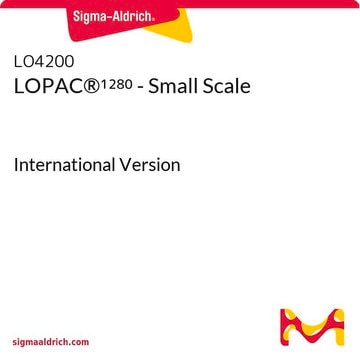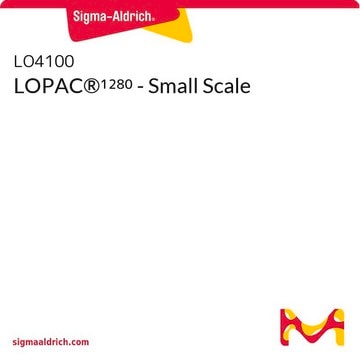LO1280
LOPAC®1280
Sinónimos:
Library of Pharmacologically Active Compounds
About This Item
Productos recomendados
form
liquid
shipped in
dry ice
storage temp.
−20°C
General description
Application
- in the screening of novel inhibitors for chemotaxis/ migration using Dictyostelium as a model
- to test the ability to modulate and to measure forskolin-stimulated cAMP levels in CHO-hCB2 cells and to modulate ligand-induced receptor/β-arrestin interaction
- in screening of small molecules for activating bone morphogenetic protein (BMP) signaling
- in screening of compounds that plays a role in regulating subcellular localization of nitric oxide associated protein 1 (NOA1) protein
Features and Benefits
- Apoptosis
- G Proteins & Cyclic Nucleotides
- Gene Regulation & Expression
- Ion Channels
- Lipid Signaling
- Multi-Drug Resistance
- Neurotransmission
- Phosphorylation
- Structure
- Primary Name
- Secondary Name
- Pharmacological Activity
- Product Number
- Rack Position
Other Notes
Legal Information
signalword
Danger
Hazard Classifications
Acute Tox. 2 Dermal - Acute Tox. 2 Inhalation - Acute Tox. 2 Oral - Aquatic Acute 1 - Aquatic Chronic 1 - Carc. 1A - Eye Dam. 1 - Lact. - Muta. 1B - Repr. 1A - Resp. Sens. 1 - Skin Corr. 1B - Skin Sens. 1 - STOT RE 2 - STOT SE 2
Storage Class
6.1A - Combustible acute toxic Cat. 1 and 2 / very toxic hazardous materials
flash_point_f
188.6 °F - closed cup
flash_point_c
87 °C - closed cup
Certificados de análisis (COA)
Busque Certificados de análisis (COA) introduciendo el número de lote del producto. Los números de lote se encuentran en la etiqueta del producto después de las palabras «Lot» o «Batch»
¿Ya tiene este producto?
Encuentre la documentación para los productos que ha comprado recientemente en la Biblioteca de documentos.
Los clientes también vieron
Artículos
Explore compound library screening options with our Pharmacologically Active Compounds portfolio.
Nuestro equipo de científicos tiene experiencia en todas las áreas de investigación: Ciencias de la vida, Ciencia de los materiales, Síntesis química, Cromatografía, Analítica y muchas otras.
Póngase en contacto con el Servicio técnico

![N'-HYDROXY-1-METHYL-2-[2-(PHENYLSULFANYL)ETHYLIDENE]HYDRAZINECARBOXIMIDAMIDE SULFATE AldrichCPR](/deepweb/assets/sigmaaldrich/product/structures/273/761/717af332-cc45-4118-bbbe-4103581033f2/640/717af332-cc45-4118-bbbe-4103581033f2.png)












